

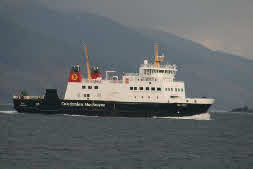
The CalMac ferry ‘‘Bute’ (left) heads out of Rothesay en route for Wemyss Bay on the mainland of Scotland. The ‘Bute’ and its sister ship the ‘Argyll’ provide a 30 minute ferry crossing. There is something about catching a ferry that can turn a mundane trip into a special one. And so it was when my wife, grandson and I caught the mid-day ferry to Rothesay for our five-day stay on the Island.
No longer would anyone say to me “What, you have never been to Rothesay” The Isle of Bute and lovely Rothesay Bay has been a tourist destination for years, ever since people started going “doon the watter fur the fair”. Okay, it is not as pristine nor as dramatic as Skye or as full of whisky as Islay, but it was the ideal location for a week’s holiday for two ‘wrinklies’ and a golf-crazy grandson on the last week of the Autumn school holidays.
Our Hotel for the week was the Glenburn Hotel which was set in an outstanding position above its own terraced gardens and enjoyed panoramic views across the waters of Rothesay Bay to the Cowal Peninsula. The town’s harbour, medieval castle ruins and sporting facilities (including the Rothesay Golf Club and Port Bannatyne Golf Club) are just a short 5-minute drive from the Hotel.
Our Hotel for the week was the Glenburn Hotel which was set in an outstanding position above its own terraced gardens and enjoyed panoramic views across the waters of Rothesay Bay to the Cowal Peninsula. The town’s harbour, medieval castle ruins and sporting facilities (including the Rothesay Golf Club and Port Bannatyne Golf Club) are just a short 5-
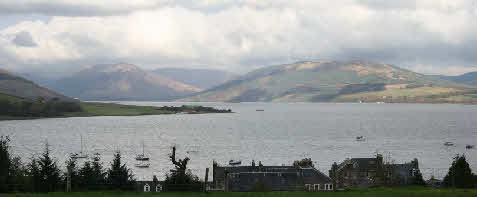
The panoramic view from Port Bannatyne to the Cowal Peninsula
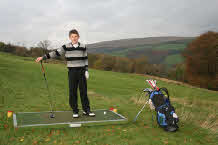
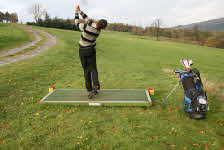
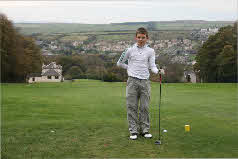
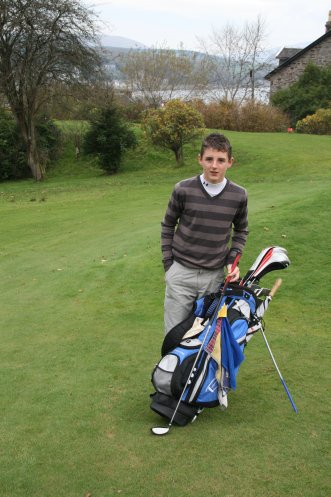
Grandson Liam on the first tee at Rothesay Golf Club (left) and at Port Bannatyne (top right). Driving off the first at Port Bannatyne (centre) and admiring the view over Rothesay (above, bottom right)
Bute is a beautiful, pastoral island on Scotlands west coast. Only 30 miles from Glasgow,the island offers all the benefits of Scottish island without the tiresome travel arrangements of destinations further afield.
Do go and experience the wonderful splendour of Mount Stuart House and Gardens and the classic Victorian seafront facade where the promenade and pier in Rothesay were in fact built on land reclaimed from the sea. The original shoreline is about 200 metres inland in front of Rothesay Castle which once stood guard over the bay.
Bute has been occupied by man for over 5500 years. An exploration of the island will reveal standing stones, cists and a vitrified fort in the south at Dunagoil Bay. Many archaeological finds are on display at the Bute Museum in Stuart St. Early Christian sites dedicated to St Ninian & St Blane speak of the missionary faith of the first inhabitants of Bute.
There is a wonderful view to Arran at the southern end of island and of course, Bute is the ancestral home of the Stuart Kings of Scotland. The 800 year old ruin of Rothesay castle was built by a hereditary High Steward of Scotland from which the surname Stewart, and later Stuart was derived. The circular design of the castle is unique in Scotland and withstood many onslaughts including an invasion by the Vikings. It was captured by the English during the wars of independence but in 1311 was retaken by Robert the Bruce. Partially destroyed by Oliver Cromwell’s troops in 1659 and finally burned and sacked by the Duke of Argyll in 1685 the castle has been substantially restored over the last 120 years.
Under the 2nd Earl of Bute the Stuart family moved 7 miles to the south of Rothesay and built Mount Stuart House on an estate of 300 acres. This original Mount Stuart house was partially destroyed in a disastrous fire in 1877, however the 3rd Marquess of Bute was inspired by his artistic, religious and astrological interests to build one of the most magnificent Victorian Gothic mansions in the world.
Over the centuries the Isle of Bute has attracted many people who savour the peace & quiet and the friendly reception afforded to incomers. Lord Attenborough, the acclaimed film director and actor has a home on the island, but one of Bute’s most colourful past residents was the 19th century Shakespearean actor Edmund Kean. Kean came from a humble background, but he became one of the most famous and wealthiest actors of his time. In 1824 he moved into Woodend House on the shores of Loch Fad. He had bought a lease on 20 acres of land and built this beautiful Georgian home in a very secluded spot.
More recently Rothesay was the birthplace of the child star, the late Lena Zavaroni. Lena was launched on to the world stage before the age ot ten, after winning a TV talent contest and went on to sing with such icons as Frank Sinatra. She had a marvellously powerful voice and a precocious stage presence, however fame and an eating disorder took its toll and Lena died tragically young in 1999.
So do take that Ferry from Wemyss Bay and enjoy a wonderful trip, as in the old days , “doon the watter”.
Do go and experience the wonderful splendour of Mount Stuart House and Gardens and the classic Victorian seafront facade where the promenade and pier in Rothesay were in fact built on land reclaimed from the sea. The original shoreline is about 200 metres inland in front of Rothesay Castle which once stood guard over the bay.
Bute has been occupied by man for over 5500 years. An exploration of the island will reveal standing stones, cists and a vitrified fort in the south at Dunagoil Bay. Many archaeological finds are on display at the Bute Museum in Stuart St. Early Christian sites dedicated to St Ninian & St Blane speak of the missionary faith of the first inhabitants of Bute.
There is a wonderful view to Arran at the southern end of island and of course, Bute is the ancestral home of the Stuart Kings of Scotland. The 800 year old ruin of Rothesay castle was built by a hereditary High Steward of Scotland from which the surname Stewart, and later Stuart was derived. The circular design of the castle is unique in Scotland and withstood many onslaughts including an invasion by the Vikings. It was captured by the English during the wars of independence but in 1311 was retaken by Robert the Bruce. Partially destroyed by Oliver Cromwell’s troops in 1659 and finally burned and sacked by the Duke of Argyll in 1685 the castle has been substantially restored over the last 120 years.
Under the 2nd Earl of Bute the Stuart family moved 7 miles to the south of Rothesay and built Mount Stuart House on an estate of 300 acres. This original Mount Stuart house was partially destroyed in a disastrous fire in 1877, however the 3rd Marquess of Bute was inspired by his artistic, religious and astrological interests to build one of the most magnificent Victorian Gothic mansions in the world.
Over the centuries the Isle of Bute has attracted many people who savour the peace & quiet and the friendly reception afforded to incomers. Lord Attenborough, the acclaimed film director and actor has a home on the island, but one of Bute’s most colourful past residents was the 19th century Shakespearean actor Edmund Kean. Kean came from a humble background, but he became one of the most famous and wealthiest actors of his time. In 1824 he moved into Woodend House on the shores of Loch Fad. He had bought a lease on 20 acres of land and built this beautiful Georgian home in a very secluded spot.
More recently Rothesay was the birthplace of the child star, the late Lena Zavaroni. Lena was launched on to the world stage before the age ot ten, after winning a TV talent contest and went on to sing with such icons as Frank Sinatra. She had a marvellously powerful voice and a precocious stage presence, however fame and an eating disorder took its toll and Lena died tragically young in 1999.
So do take that Ferry from Wemyss Bay and enjoy a wonderful trip, as in the old days , “doon the watter”.
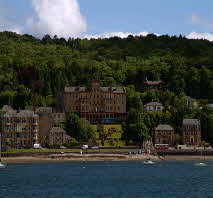
Glenburn Hotel




